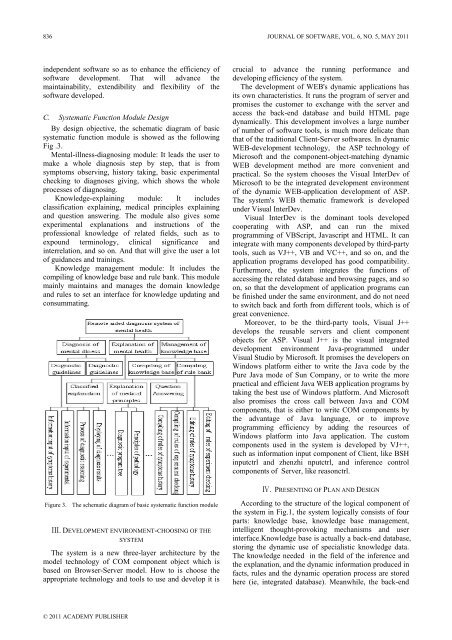Journal of Software - Academy Publisher
Journal of Software - Academy Publisher
Journal of Software - Academy Publisher
You also want an ePaper? Increase the reach of your titles
YUMPU automatically turns print PDFs into web optimized ePapers that Google loves.
836 JOURNAL OF SOFTWARE, VOL. 6, NO. 5, MAY 2011<br />
independent s<strong>of</strong>tware so as to enhance the efficiency <strong>of</strong><br />
s<strong>of</strong>tware development. That will advance the<br />
maintainability, extendibility and flexibility <strong>of</strong> the<br />
s<strong>of</strong>tware developed.<br />
C. Systematic Function Module Design<br />
By design objective, the schematic diagram <strong>of</strong> basic<br />
systematic function module is showed as the following<br />
Fig .3.<br />
Mental-illness-diagnosing module: It leads the user to<br />
make a whole diagnosis step by step, that is from<br />
symptoms observing, history taking, basic experimental<br />
checking to diagnoses giving, which shows the whole<br />
processes <strong>of</strong> diagnosing.<br />
Knowledge-explaining module: It includes<br />
classification explaining, medical principles explaining<br />
and question answering. The module also gives some<br />
experimental explanations and instructions <strong>of</strong> the<br />
pr<strong>of</strong>essional knowledge <strong>of</strong> related fields, such as to<br />
expound terminology, clinical significance and<br />
interrelation, and so on. And that will give the user a lot<br />
<strong>of</strong> guidances and trainings.<br />
Knowledge management module: It includes the<br />
compiling <strong>of</strong> knowledge base and rule bank. This module<br />
mainly maintains and manages the domain knowledge<br />
and rules to set an interface for knowledge updating and<br />
consummating.<br />
Figure 3. The schematic diagram <strong>of</strong> basic systematic function module<br />
Ⅲ. DEVELOPMENT ENVIRONMENT-CHOOSING OF THE<br />
SYSTEM<br />
The system is a new three-layer architecture by the<br />
model technology <strong>of</strong> COM component object which is<br />
based on Browser-Server model. How to is choose the<br />
appropriate technology and tools to use and develop it is<br />
© 2011 ACADEMY PUBLISHER<br />
crucial to advance the running performance and<br />
developing efficiency <strong>of</strong> the system.<br />
The development <strong>of</strong> WEB's dynamic applications has<br />
its own characteristics. It runs the program <strong>of</strong> server and<br />
promises the customer to exchange with the server and<br />
access the back-end database and build HTML page<br />
dynamically. This development involves a large number<br />
<strong>of</strong> number <strong>of</strong> s<strong>of</strong>tware tools, is much more delicate than<br />
that <strong>of</strong> the traditional Client-Server s<strong>of</strong>twares. In dynamic<br />
WEB-development technology, the ASP technology <strong>of</strong><br />
Micros<strong>of</strong>t and the component-object-matching dynamic<br />
WEB development method are more convenient and<br />
practical. So the system chooses the Visual InterDev <strong>of</strong><br />
Micros<strong>of</strong>t to be the integrated development environment<br />
<strong>of</strong> the dynamic WEB-application development <strong>of</strong> ASP.<br />
The system's WEB thematic framework is developed<br />
under Visual InterDev.<br />
Visual InterDev is the dominant tools developed<br />
cooperating with ASP, and can run the mixed<br />
programming <strong>of</strong> VBScript, Javascript and HTML. It can<br />
integrate with many components developed by third-party<br />
tools, such as VJ++, VB and VC++, and so on, and the<br />
application programs developed has good compatibility.<br />
Furthermore, the system integrates the functions <strong>of</strong><br />
accessing the related database and browsing pages, and so<br />
on, so that the development <strong>of</strong> application programs can<br />
be finished under the same environment, and do not need<br />
to switch back and forth from different tools, which is <strong>of</strong><br />
great convenience.<br />
Moreover, to be the third-party tools, Visual J++<br />
develops the reusable servers and client component<br />
objects for ASP. Visual J++ is the visual integrated<br />
development environment Java-programmed under<br />
Visual Studio by Micros<strong>of</strong>t. It promises the developers on<br />
Windows platform either to write the Java code by the<br />
Pure Java mode <strong>of</strong> Sun Company, or to write the more<br />
practical and efficient Java WEB application programs by<br />
taking the best use <strong>of</strong> Windows platform. And Micros<strong>of</strong>t<br />
also promises the cross call between Java and COM<br />
components, that is either to write COM components by<br />
the advantage <strong>of</strong> Java language, or to improve<br />
programming efficiency by adding the resources <strong>of</strong><br />
Windows platform into Java application. The custom<br />
components used in the system is developed by VJ++,<br />
such as information input component <strong>of</strong> Client, like BSH<br />
inputctrl and zhenzhi nputctrl, and inference control<br />
components <strong>of</strong> Server, like reasonctrl.<br />
Ⅳ. PRESENTING OF PLAN AND DESIGN<br />
According to the structure <strong>of</strong> the logical component <strong>of</strong><br />
the system in Fig.1, the system logically consists <strong>of</strong> four<br />
parts: knowledge base, knowledge base management,<br />
intelligent thought-provoking mechanisms and user<br />
interface.Knowledge base is actually a back-end database,<br />
storing the dynamic use <strong>of</strong> specialistic knowledge data.<br />
The knowledge needed in the field <strong>of</strong> the inference and<br />
the explanation, and the dynamic information produced in<br />
facts, rules and the dynamic operation process are stored<br />
here (ie, integrated database). Meanwhile, the back-end

















